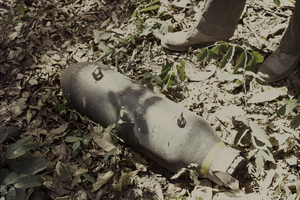قنبلة


القنبلة هي أداة متفجرة. بالرغم من أنها لا تحتوي على طاقة أكثر من الوقود العادي، إلا في حالة الأسلحة النووية، تولد وتصدر طاقتها بسرعة كبيرة، كموجات اهتزازية تدميرية عنيفة. هي عادة نوع من الحاويات تملأ بالمادة المتفجرة، وهي مصممة لتسبب الدمار العشوائي عندما تبدأ.
القنبلة نوع من أنواع الأسلحة؛ إلا أن لها استعمالات أخرى في الأغراض المدنية، مثل البناء أو التعدين. العديد من الأدوات المتفجرة العسكرية لا تدعى قنابل. الأدوات المتفجرة العسكرية الأخرى تدعو القنابل اليدوية، أو القذائف، أو الرؤوس الحربية، أو الألغام الأرضية، أو غيرها. لقرون عديدة تستعمل القنابل في الحرب وهي جزء مركزي من ترسانة المحاربين. يميز الخبراء عموماً بين القنابل المدنية والعسكرية. إن القنبلة الأقوى في الوجود هي القنبلة الهيدروجينية، وهي سلاح نووي. استعملت القنابل الأقوى في المعارك بواسطة الولايات المتحدة عند مهاجمتها لهيروشيما وناكاساكي (انظر الضربة النووية على هيروشيما و ناگاساكي). إن القنبلة اللا نووية الأقوى هي قنبلة القوة الجوية الأمريكية MOAB وتدعى أيضا أم القنابل.
التاريخ

التشظي
 مقالة مفصلة: تشظي (سلاح)
مقالة مفصلة: تشظي (سلاح)
الأنواع



المضادة للمادة
Antimatter bombs can theoretically be constructed, but antimatter is very costly to produce and hard to store safely.
غيرهم
- Aerial bomb
- Delay-action bomb
- Glide bomb
- General-purpose bomb
- Incendiary bomb - Incendiary bombs are designed to set targets ablaze.
- Cluster bomb
- Anti-runway penetration bomb
- Bunker buster
- Concrete bomb - A concrete bomb is an aerial bomb which contains dense, inert material (typically concrete, hence the name) instead of explosive. The target is destroyed using the kinetic energy of the falling bomb.
- Inert bomb
An inert bomb is one whose inner energetic material has been removed or otherwise rendered harmless. Inert munitions are used in military and naval training, and they are also collected and displayed by public museums, or by private parties.
Typically, NATO inert munitions are painted entirely in light blue and/or have the word "INERT" stenciled on them in prominent locations.[بحاجة لمصدر]
التوصيل

The first air-dropped bombs were used by the Austrians in the 1849 siege of Venice. Two hundred unmanned balloons carried small bombs, although few bombs actually hit the city.[3]
انظر أيضاً
المراجع
- ^ Joseph Needham (1986). Military Technology: The Gunpowder Epic. Cambridge University Press. pp. 189–190. ISBN 978-0-521-30358-3. Archived from the original on 2016-08-26.
- ^ Joseph Needham (1974). Science and Civilisation in China: Military technology : the gunpowder epic. Cambridge University Press. p. 191. ISBN 978-0-521-30358-3. Archived from the original on 2016-08-26.
- ^ Murphy, Justin (2005). Military Aircraft, Origins to 1918: An Illustrated History of their Impact. ABC-CLIO. p. 10. ISBN 1-85109-488-1. Retrieved 2008-05-26.
وصلات خارجية
- Explosive Violence, The Problem of Explosive Weapons A report by Richard Moyes (Landmine Action, 2009) on the humanitarian problems caused by the use of bombs and other explosive weapons in populated areas
- FAS.org Bombs for Beginners
- MakeItLouder.com How a bomb functions and rating their power


